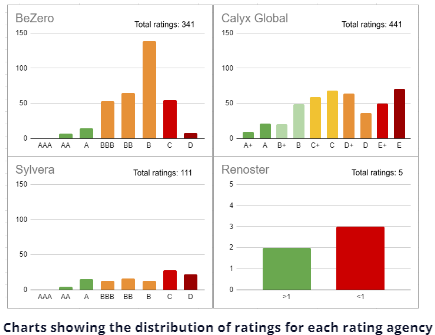Rating agencies are considered to play a valuable role in assessing the quality of credits in the voluntary carbon market (VCM), but do they? Our latest report sheds light on their performance.
On 11 September 2023, Carbon Market Watch (CMW) released the findings of a Perspective Climate Group study we commissioned assessing the value added to the VCM, and more importantly the climate, by four major carbon credit rating agencies BeZero, Calyx Global, Sylvera and Renoster. Titled ‘Rating the raters’, the accompanying CMW briefing suggests recommendations not only for rating agencies, but also for carbon credit buyers.
Good, can do better
Rating agencies do not award carbon credits to projects, but they have emerged as assessors independently evaluating the likelihood of whether or not a credit generated by a certified project is truly representative of a tonne of carbon dioxide equivalent (CO2e) reduction or removal. More often than not rating agencies attribute medium to low scores to projects, demonstrating the scrupulous quality of their evaluations relative to the liberal approval of the carbon crediting standards.

“The fact that so few credits receive the highest score from rating agencies proves that the idea that emissions can be offset or compensated for using carbon credits is an illusion,” explained Benja Faecks, expert on global carbon markets and author of the CMW briefing. “This makes them unsuitable to offset emissions.”
However, there is no uniform, aligned approach taken by the rating agencies and the variety of end results has led to a confused marketplace. With agencies using different grading scales, a given grade – for example “B” – can imply significantly different levels of quality depending on the agency that is assigning it. While such a rating might be taken at face value as being the second best result, for some agencies it is actually only the sixth best.
“Our report card says that rating agencies are playing a useful role in the market as they rightly point out that all credits are not equal,” Faecks summarised. “Nevertheless, there is room for improvement as both their rating approaches and the actual ratings they distribute are not easy for investors to understand, and frequently contradict each other.”
Raising the bar
The comments follow an assessment of how each of the selected rating agencies analyses five key credit indicators – ‘baseline setting’, ‘additionality’, ‘non-permanence risks’, ‘leakage risks’, and ‘co-benefits and safeguards’ (See note below).
By highlighting areas for improvements in individual case studies, our analysis shows that the rating agencies are capable of improving quality in the market.
Yet, in adopting lenient approaches to assessment or failing to capture the nuances of a project’s environmental performance, they also run the risk of legitimising the use of low-quality credits. This is a real danger that rating agencies should take very seriously. The CMW assessment has suggested a range of improvements for each agency to make that will raise the bar.
Buying into change
Buyers also have a role to play in improving the climate benefit generated by the VCM. In better understanding rating agency frameworks and the nuances of why junk carbon credits are not what they claim to be, buyers will be more knowledgeable about which credits to invest in and how to use them responsibly, i.e. not to offset their emissions but as a “contribution” to climate action. The imperfect scores delivered by rating agencies show that carbon credits do not provide a silver bullet that will help buyers gain “carbon neutrality” status or reach climate targets.
“Rating agencies can be the agents of change in a world that moves away from compensation and offsetting towards less absolute claims of climate contributions,” Faecks concludes. “This opens the door to more transparent and honest communication about the different impacts that carbon credits truly represent.”
Note
| Terms explained ‘Baseline setting’ is an estimation of the counterfactual scenario (that is, what would have happened without the project) and is useful, among other things, to determine the impact of the project. It is connected to the question of ‘additionality,’ which aims to assess whether the climate benefits are occuring due to the project, or due to other factors. ‘Non-permanence risks’ establish how likely it is that stored carbon will be released back into the atmosphere, while ‘leakage risks’ addresses whether projects truly reduce emissions, or result in them shifting elsewhere. ‘Co-benefits and safeguards’ investigates if a project delivers benefits beyond reducing emissions, and, at a minimum, whether it protects local communities, indigenous peoples, and the environment from harm. |
Author
-
Gavin is a member of the communications team. He formerly supported the work of MSPs in the Scottish Parliament, and held responsibility for media output and office management for two MEPs prior to Brexit. He is an experienced campaigner, relishing the challenge of communicating for causes that have a social and environmental impact and is motivated by CMW’s mission of holding businesses and governments to account as they move towards essential environmental ambitions and transitions. When not fighting the good fight Gavin can typically be found enjoying live music or attending to his houseplants.
View all posts





